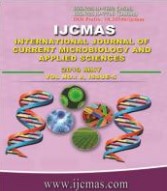


 National Academy of Agricultural Sciences (NAAS)
National Academy of Agricultural Sciences (NAAS)

|
PRINT ISSN : 2319-7692
Online ISSN : 2319-7706 Issues : 12 per year Publisher : Excellent Publishers Email : editorijcmas@gmail.com / submit@ijcmas.com Editor-in-chief: Dr.M.Prakash Index Copernicus ICV 2018: 95.39 NAAS RATING 2020: 5.38 |
Bakanae of rice cause by Fusarium moniliforme [sexual stage: Gibberella fujikuroi] is one of the important diseases of rice occurring throughout rice (Oryza sativa L.) growing regions of the world. Bakanae disease also known as “Foolish seedling disease” is emerged as a significantly important disease in rice growing country in Asia.The word Bakanae is derived from the Japanese word which means “Foolish”. The incidence of this disease was reported high from the part of Punjab, Haryana and Uttarakhand and responsible for 15 % losses throughout the India. This disease is reported as both soil and seed borne and contains 15 forms of gibberellins out of 72 forms which make difficult to develop disease resistance varieties against this disease. The causative agent of bakane “Fusarium fujikuroi” produce secondary metabolites fusaric acids and gibberellic acid (GA) which result in the taller plantlet in the field with empty panicles. For the management of this disease various physical, chemical and biological methods are being used however, chemical method is most preferred over other method due to complexity of this disease and broader host range of pathogen. In recent years, the incidence of bakane disease is increasing season to season in the Punjab and Haryana. Development and application of proper management technique will become strong challenge in future in rice based cropping system in the various places of Punjab and Haryana.
 |
 |
 |
 |
 |